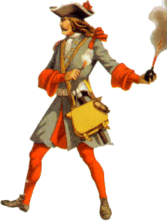The Rhenish Front, 1683-1865
From The Campaigns of Modernity, by C. De Villenueve
The Franco-Dutch War consisted of two phases: one, a short period of time during the spring and summer of 1683, during which the French made rapid gains, taking Luxemburg and reinforcing the cities of the Dutch Bourbons. The betrayal of Marlborough and the switch retaking of the area up to the Rhine ended this phase, and the war became a brutal slog, with few decisive battles.
While Marlborough was able to inflict a horrid blow on the French army, he soon found that he was unable to make good on his counteroffensive. After spending his whole life around professional armies and mercenaries, Marlborough had to face one of the greatest flaws of the new mass armies marching across Europe: the harvest season. As summer turned to fall, much of Johann’s army left the field to go back to their villages and towns, desperate to keep the fragile economy of the northern Netherlands from the brink of total agricultural and economic collapse. The Netherlands was also experiencing a famine, and with the Scandinavians blocking off the Baltic Sea, a large portion of Polish surplus wheat was unavailable for Western Europe. Few peasants returned to the Dutch army, and for three years the Dutch front was silent, with Marlborough leading several attacks against Antwerp, Brabant, and Limburg, only to be repulsed by Vauban’s men and put into a position of begging parliament and Johann for yet more troops.
Marlborough’s three attacks on 1684, 85, and 86. Each was met by the Garrison Mobilisé, a mobile force of siege engineers and grenadiers led by Vauban who reinforced and strengthened each city they came across. The Garrison Mobilisé became the most decorated unit of the war, and was later incorporated into the Armeé de Bourbon.
While the Dutch front remained silent due to lack of reinforcements from both the Coalition and the French, the Rhenish front became the major focus point of the war. While the Leger van de Valois was incapable of maintaining its size due to the peasantry’s need to tend the fields in a lengthened famine, Saxony and Prussia had no such problems. Eastern Europe faced perfect weather for planting, and without access to overseas markets Prussia exported much of its wheat to Saxony, allowing both kingdoms to maintain their armies at full capacity.
Because most professional troops were sent to the Dutch front, de Savoie was left with an army comprised mostly of conscripted peasants and artisans. This put the Rhenish Front at the fore of a new kind of warfare. Furthermore, the armies fighting on the Rhine were larger and more expensive than any point before. The largest army France had ever sent to the front beforehand went with Louis XII, which was 50,000 in size. In comparison, the armies fighting each other in the Rhenish Confederacy were each a hundred thousand strong. Each army was more effectively led than before, with a sizeable force of non-commissioned officers making sure that Colbert’s and August’s rules were followed. Over-ambitious generals were checked and for the first time, a King’s strategy could be felt in the front even if he was not there himself.
Soldiers ignoring their generals’ order
With the generals tamed, another force increasingly became problematic: the disciplining of the troops. Unlike the last period of mass warfare, there was no element of religious conflict in the War of the Rhine; France was defending a mixed ally against Protestants in order to support another Protestant monarchy. As the 17th century turned to the 18th, the religious tenor of Europe’s major wars desisted, and it became clearer and clearer that war was a battle for existence between religions but was rather a battle for the benefit of kings. Soldier’s songs became markedly more dour and rebellious over the period, mostly expressing a desire to return to the farm and a confusion as to what exactly they were fighting for.
This lack of passion on the part of the soldiers was seen through the three years that generals de Savoie and von Eilenburg spared from Mannheim to Wurzburg. Although the armies engaged with each other were the largest the world had seen since Cannae, this did as much good as ill. The armies were too large to engage with each other on any less than perfect conditions, and instead of that, they sent brigades against each other for reconnaissance and in order to take what small patches of advantageous ground they could. Inevitably, these brigades would be met by a far larger force and either sent off or forced to surrender. The men of both armies were wholly unwilling to perform the kind of heroic last stand which the armies of a century before engaged in with regularity.
The Rhenish Campaign up to 1685. Grey stars indicate skirmishes won by the Saxons, blue stars were won by the French, the Grey-Blue star indicated the Battle of Zweibrucken, the first legitimate battle of the front
Despite the iron will that held brigadier generals to the orders given to them, there was no such hold on the men they led. In several cases (for the French: Aschaffenburg, Ahorn, Oschenfurt; for the Saxons: Mannheim, Sinsheim, Deiburg) we see cases of whole brigades surrendering their weapons and banners to the enemy upon the possibility of combat with a superior force. De Savoie’s dragoon regiments in particular were able to capture the banners of twelve Saxon regiments during these skirmishes, bringing up yet another oddity of this new form of warfare. Despite a series of innovations which weakened the strength of cavalry on the battlefield (in particular bayonets, which were implemented for the first time in de Savoie’s army in 1685), cavalry was as important as ever before, to the degree that each infantry brigade would include a group of cavalry. This was not so much for their skill on the battlefield or even their reconnaissance abilities, as it was the fact that they were, still, the most professional soldiers in a given army. Because of this they were unlikely to break, unlikely to rout, and their presence made sure both that a retreat wouldn’t turn into a rout and that infantry were less likely to retreat.
While von Eilenburg saw this as an advantage and relied more and more on his noble cavalry regiments, de Savoie saw this as a weakness. The dispersed cavalry of the Saxon style did not fit with France’s historic doctrines, tactics, strategy, but deviating from their methods led to a series of failed skirmishes in the northern Rhine. These failed skirmishes led up to the Battle of Zweibrucken, a total failure by the French during which most of de Savoie’s infantry were captured or lost. While the French cavalry did manage to destroy much of von Eilenburg’s cavalry, regardless the battle of Zweibrucken meant that the French had to concede the Saar to the Saxon army.
The failure at Zweibrucken did not spell the end of de Savoie, however. Von Eilenburg’s army would take months to siege Saarbrucken, and after that the five fortresses of the Moselle would be able to prevent a move into France. Furthermore, it allowed de Savoie time to implement his plan to solve the issue of his infantry’s weakness. Of the 30,000 infantry he brought to Zweibrucken, only the 9th Brigade (6,000 men) remained. These men, however, had been involved in multiple skirmishes through the year and had served with gusto in the battle of Zweibrucken, serving an excellent job as a rearguard and successfully defending the Hornback river crossing. They were experienced, hardened men, just the kind de Savoie needed.
Grenadiers were only recently introduced as a small set of soldiers who used grenades in seiges. De Savoie was the first to turn a whole brigade into grenadiers and the first to use ‘grenadier’ as merely a synonym for elite heavy infantry
The 9th Brigade was transformed, over the winter of 1685, into the 1st Grenadier Brigade. They were drilled non-stop, becoming the first infantry brigade in the French army to be taught by a standardized drill. They learned to march in lock-step, to volley-fire, to act both in loose and close order. They also became the centre of the new technologies being developed in France, such as long-wick grenades, flintlock muskets, and bayonets. The 1st Brigade was then separated into six companies, who were dispersed among the new infantry brigades recruited over the fall and winter, and tasked with training their green comrades. By the campaign season de Savoie’s army was as well trained as any army in Europe.
The Battle of Landau occurred in the Febuary of 1686, when de Savoie marched nearly all of his men to the north-eastern part of the Rhenish Confederacy to cut off the Saxon’s line of supply. The character of the battle was shown early on, during the skrimishes between Saxon cavalry and de Savoie’s new infantry brigades. Unlike earlier skirmishes, during which the infantry (Saxon or French) would crumble under the fire and shock of a cavalry company, de Savoie’s grenadiers were able to repulse the attacks against them and captured a whole company in the process.
The Battle of Landau began the conclusion of the Franco-Dutch War
When von Eidelburg marched the mass of his troops back from their winter quarters to meet de Savoie in Landau, he was marching against an entirely new army. While de Savoie had marched with 50,000 men in 1685, now he possessed an army of 75,000, and while de Savoie’s troops were green in 85, now they were a highly experienced and well drilled force. Never the less, von Eidelburg adopted the same strategy he had used in the Battle of Zweibrucken, hammering the French troops with artillery fire and sending his cavalry in with the hope of a quick victory.
This attack was met with an unexpected riposte; de Savoie had concentrated the entirety of his cavalry into two brigades of 12,000 men, and they counter-marched against von Eidelburg’s cavalry as de Savoie’s infantry continued to encircle von Eidelburg’s position. The charge of the Saxon cavalry was destroyed, and a second charge by the reserve cavalry was successfully repulsed by the new grenadier companies. With this second loss, von Eidelburg began to move to retreat, and lost two brigades as de Savoie’s cavalry overwhelmed his rearguard.
Four hours after the beginning of the Battle of Landau, the Saxons were kicked out of their position in the Rhine and were headed in a swift retreat towards Luxemburg. Hearing of this, Marlborough marched his whole army to Limburg, took it, and marched on. It seemed that the whole war would be decided by the upcoming Battle of Luxembourg.
Hey guys, sorry for the slow update, I’ve been finishing up my last final and lately I’ve been going to a lot of the marches in NYC and helping my friends get ready to move. Busy times! But the next entry or two should be the end of LoF1, so there’s that!


























